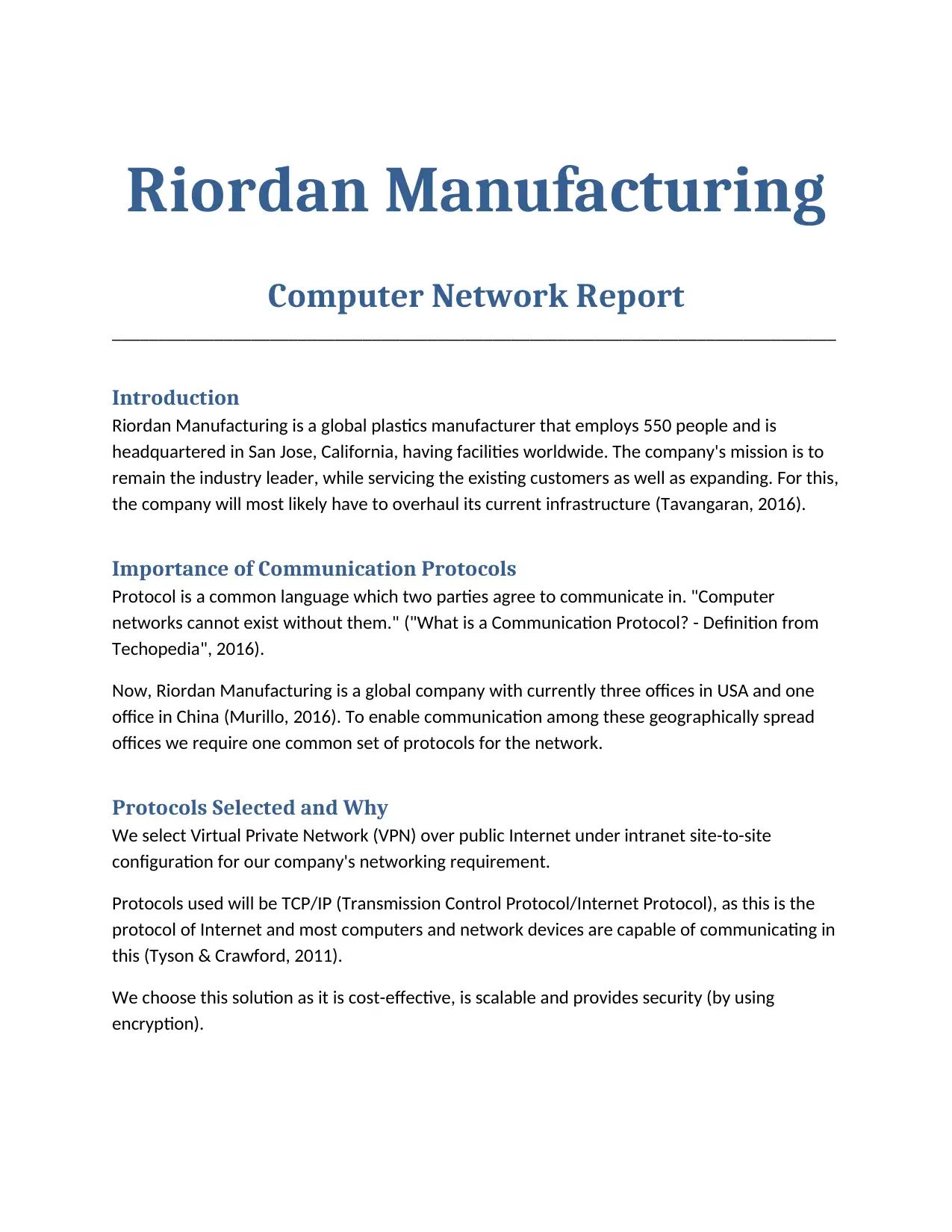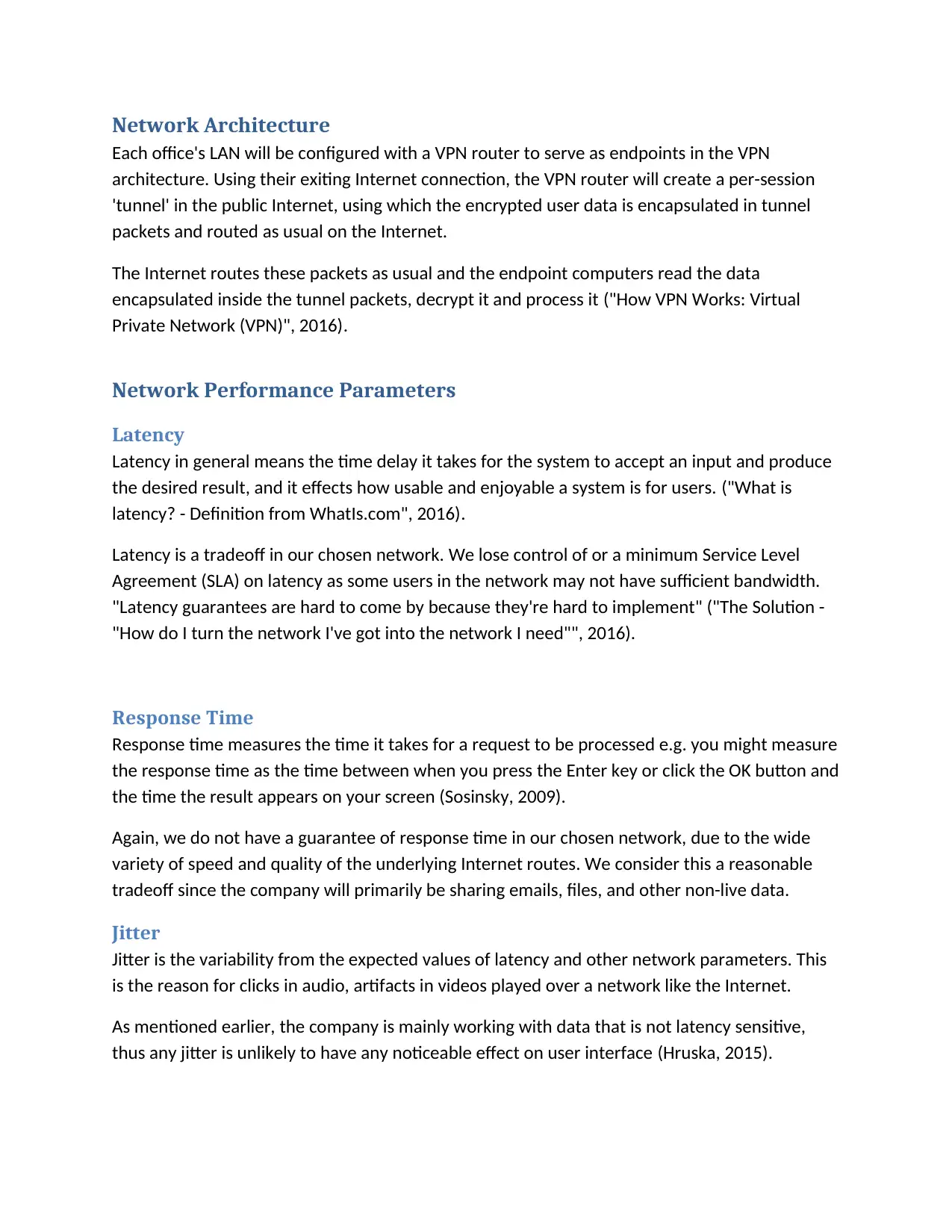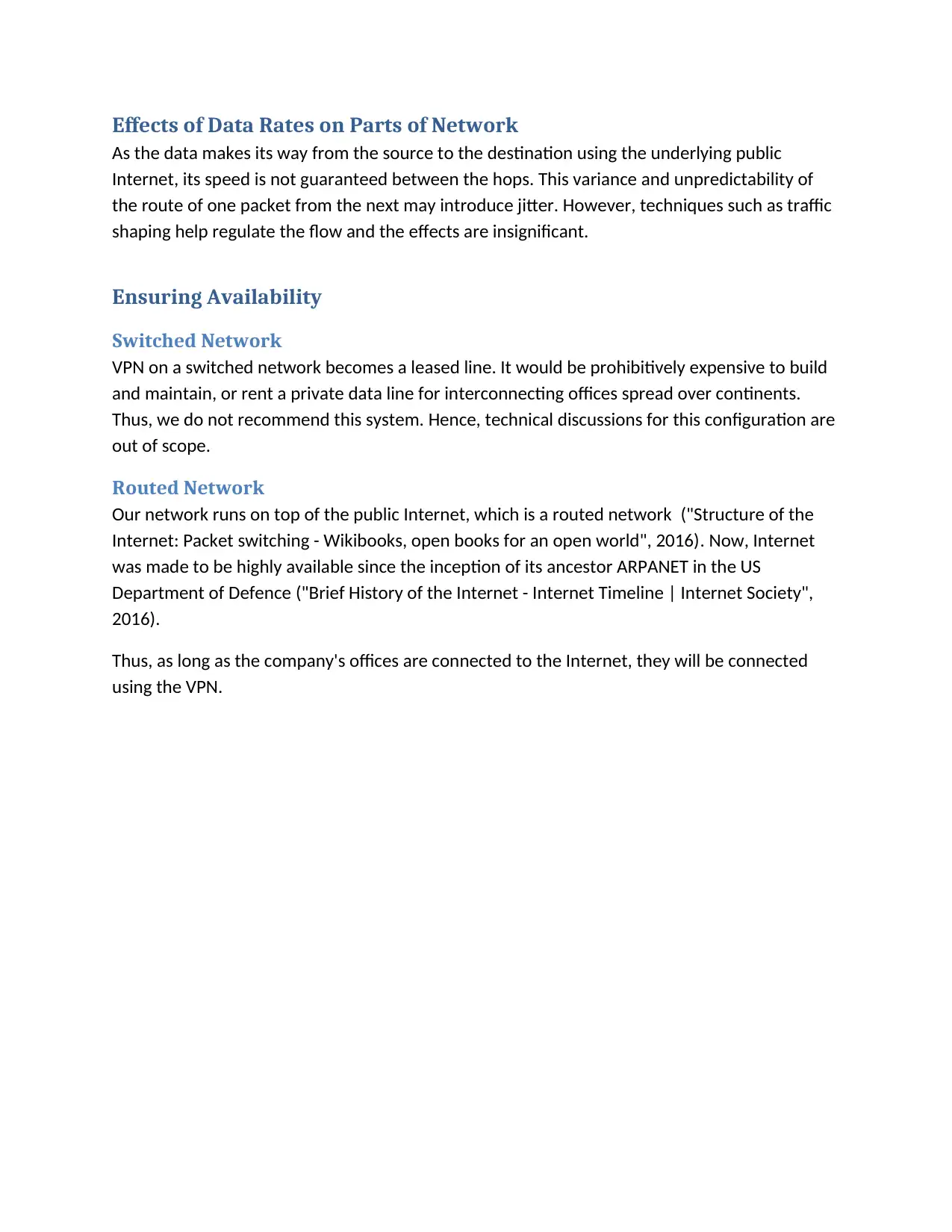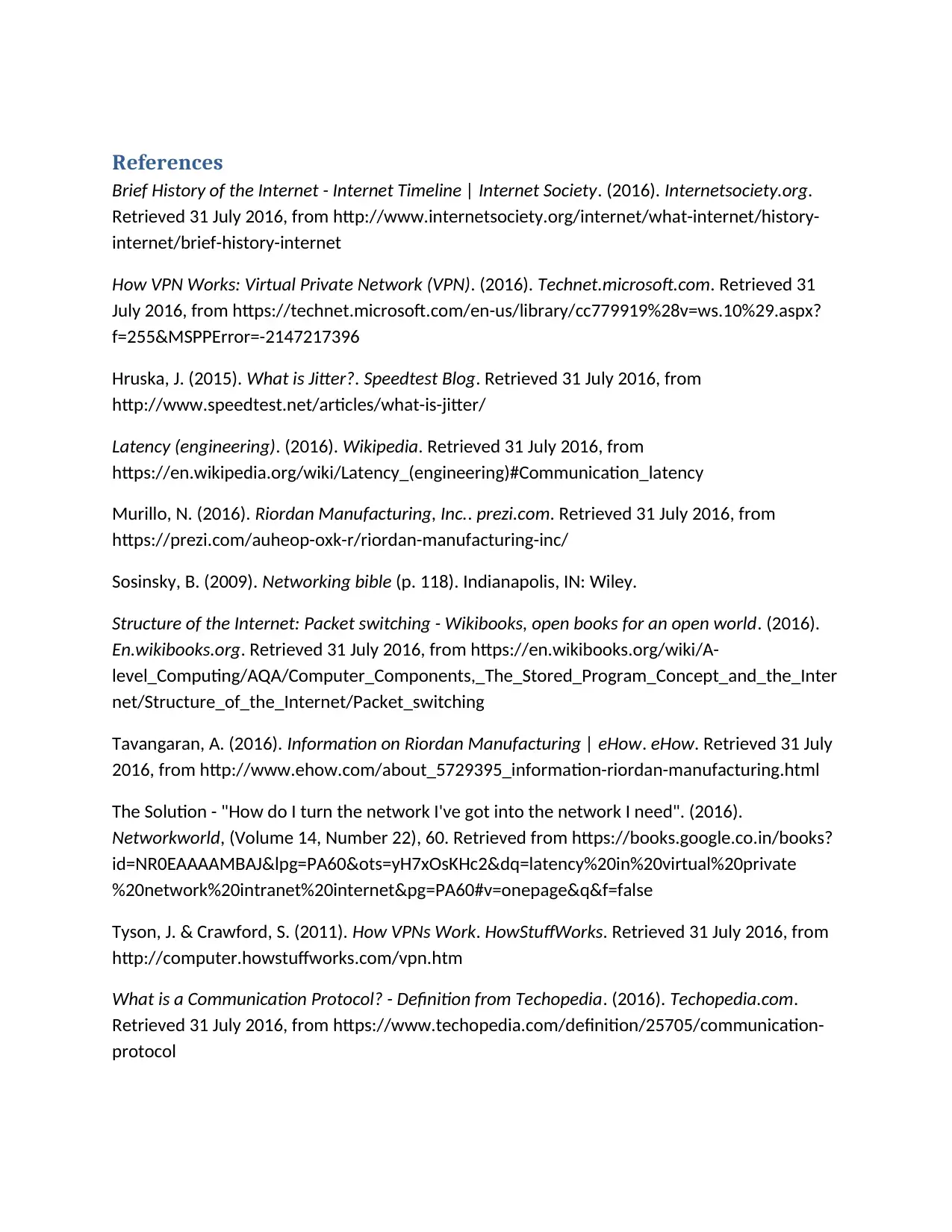Analysis of Computer Network for Riordan Manufacturing - Report
VerifiedAdded on 2019/09/24
|5
|1272
|118
Report
AI Summary
This report provides a comprehensive analysis of the computer network requirements for Riordan Manufacturing, a global plastics manufacturer with multiple offices. The core recommendation is to implement a Virtual Private Network (VPN) using a site-to-site configuration over the public Internet. The report details the selection of TCP/IP as the primary protocol and explains the rationale behind this choice, emphasizing cost-effectiveness, scalability, and security through encryption. It outlines the network architecture, with VPN routers at each office's LAN acting as endpoints, encapsulating data within 'tunnels' over the Internet. The report assesses network performance parameters, including latency, response time, and jitter, acknowledging the trade-offs inherent in using the public Internet. It also explores the effects of data rates on network parts and discusses methods to ensure network availability, specifically recommending a routed network over a switched network due to cost and practical considerations. The report references relevant sources to support its findings.

Riordan Manufacturing
Computer Network Report
______________________________________________________________________________
Introduction
Riordan Manufacturing is a global plastics manufacturer that employs 550 people and is
headquartered in San Jose, California, having facilities worldwide. The company's mission is to
remain the industry leader, while servicing the existing customers as well as expanding. For this,
the company will most likely have to overhaul its current infrastructure (Tavangaran, 2016).
Importance of Communication Protocols
Protocol is a common language which two parties agree to communicate in. "Computer
networks cannot exist without them." ("What is a Communication Protocol? - Definition from
Techopedia", 2016).
Now, Riordan Manufacturing is a global company with currently three offices in USA and one
office in China (Murillo, 2016). To enable communication among these geographically spread
offices we require one common set of protocols for the network.
Protocols Selected and Why
We select Virtual Private Network (VPN) over public Internet under intranet site-to-site
configuration for our company's networking requirement.
Protocols used will be TCP/IP (Transmission Control Protocol/Internet Protocol), as this is the
protocol of Internet and most computers and network devices are capable of communicating in
this (Tyson & Crawford, 2011).
We choose this solution as it is cost-effective, is scalable and provides security (by using
encryption).
Computer Network Report
______________________________________________________________________________
Introduction
Riordan Manufacturing is a global plastics manufacturer that employs 550 people and is
headquartered in San Jose, California, having facilities worldwide. The company's mission is to
remain the industry leader, while servicing the existing customers as well as expanding. For this,
the company will most likely have to overhaul its current infrastructure (Tavangaran, 2016).
Importance of Communication Protocols
Protocol is a common language which two parties agree to communicate in. "Computer
networks cannot exist without them." ("What is a Communication Protocol? - Definition from
Techopedia", 2016).
Now, Riordan Manufacturing is a global company with currently three offices in USA and one
office in China (Murillo, 2016). To enable communication among these geographically spread
offices we require one common set of protocols for the network.
Protocols Selected and Why
We select Virtual Private Network (VPN) over public Internet under intranet site-to-site
configuration for our company's networking requirement.
Protocols used will be TCP/IP (Transmission Control Protocol/Internet Protocol), as this is the
protocol of Internet and most computers and network devices are capable of communicating in
this (Tyson & Crawford, 2011).
We choose this solution as it is cost-effective, is scalable and provides security (by using
encryption).
Paraphrase This Document
Need a fresh take? Get an instant paraphrase of this document with our AI Paraphraser

Network Architecture
Each office's LAN will be configured with a VPN router to serve as endpoints in the VPN
architecture. Using their exiting Internet connection, the VPN router will create a per-session
'tunnel' in the public Internet, using which the encrypted user data is encapsulated in tunnel
packets and routed as usual on the Internet.
The Internet routes these packets as usual and the endpoint computers read the data
encapsulated inside the tunnel packets, decrypt it and process it ("How VPN Works: Virtual
Private Network (VPN)", 2016).
Network Performance Parameters
Latency
Latency in general means the time delay it takes for the system to accept an input and produce
the desired result, and it effects how usable and enjoyable a system is for users. ("What is
latency? - Definition from WhatIs.com", 2016).
Latency is a tradeoff in our chosen network. We lose control of or a minimum Service Level
Agreement (SLA) on latency as some users in the network may not have sufficient bandwidth.
"Latency guarantees are hard to come by because they're hard to implement" ("The Solution -
"How do I turn the network I've got into the network I need"", 2016).
Response Time
Response time measures the time it takes for a request to be processed e.g. you might measure
the response time as the time between when you press the Enter key or click the OK button and
the time the result appears on your screen (Sosinsky, 2009).
Again, we do not have a guarantee of response time in our chosen network, due to the wide
variety of speed and quality of the underlying Internet routes. We consider this a reasonable
tradeoff since the company will primarily be sharing emails, files, and other non-live data.
Jitter
Jitter is the variability from the expected values of latency and other network parameters. This
is the reason for clicks in audio, artifacts in videos played over a network like the Internet.
As mentioned earlier, the company is mainly working with data that is not latency sensitive,
thus any jitter is unlikely to have any noticeable effect on user interface (Hruska, 2015).
Each office's LAN will be configured with a VPN router to serve as endpoints in the VPN
architecture. Using their exiting Internet connection, the VPN router will create a per-session
'tunnel' in the public Internet, using which the encrypted user data is encapsulated in tunnel
packets and routed as usual on the Internet.
The Internet routes these packets as usual and the endpoint computers read the data
encapsulated inside the tunnel packets, decrypt it and process it ("How VPN Works: Virtual
Private Network (VPN)", 2016).
Network Performance Parameters
Latency
Latency in general means the time delay it takes for the system to accept an input and produce
the desired result, and it effects how usable and enjoyable a system is for users. ("What is
latency? - Definition from WhatIs.com", 2016).
Latency is a tradeoff in our chosen network. We lose control of or a minimum Service Level
Agreement (SLA) on latency as some users in the network may not have sufficient bandwidth.
"Latency guarantees are hard to come by because they're hard to implement" ("The Solution -
"How do I turn the network I've got into the network I need"", 2016).
Response Time
Response time measures the time it takes for a request to be processed e.g. you might measure
the response time as the time between when you press the Enter key or click the OK button and
the time the result appears on your screen (Sosinsky, 2009).
Again, we do not have a guarantee of response time in our chosen network, due to the wide
variety of speed and quality of the underlying Internet routes. We consider this a reasonable
tradeoff since the company will primarily be sharing emails, files, and other non-live data.
Jitter
Jitter is the variability from the expected values of latency and other network parameters. This
is the reason for clicks in audio, artifacts in videos played over a network like the Internet.
As mentioned earlier, the company is mainly working with data that is not latency sensitive,
thus any jitter is unlikely to have any noticeable effect on user interface (Hruska, 2015).

Effects of Data Rates on Parts of Network
As the data makes its way from the source to the destination using the underlying public
Internet, its speed is not guaranteed between the hops. This variance and unpredictability of
the route of one packet from the next may introduce jitter. However, techniques such as traffic
shaping help regulate the flow and the effects are insignificant.
Ensuring Availability
Switched Network
VPN on a switched network becomes a leased line. It would be prohibitively expensive to build
and maintain, or rent a private data line for interconnecting offices spread over continents.
Thus, we do not recommend this system. Hence, technical discussions for this configuration are
out of scope.
Routed Network
Our network runs on top of the public Internet, which is a routed network ("Structure of the
Internet: Packet switching - Wikibooks, open books for an open world", 2016). Now, Internet
was made to be highly available since the inception of its ancestor ARPANET in the US
Department of Defence ("Brief History of the Internet - Internet Timeline | Internet Society",
2016).
Thus, as long as the company's offices are connected to the Internet, they will be connected
using the VPN.
As the data makes its way from the source to the destination using the underlying public
Internet, its speed is not guaranteed between the hops. This variance and unpredictability of
the route of one packet from the next may introduce jitter. However, techniques such as traffic
shaping help regulate the flow and the effects are insignificant.
Ensuring Availability
Switched Network
VPN on a switched network becomes a leased line. It would be prohibitively expensive to build
and maintain, or rent a private data line for interconnecting offices spread over continents.
Thus, we do not recommend this system. Hence, technical discussions for this configuration are
out of scope.
Routed Network
Our network runs on top of the public Internet, which is a routed network ("Structure of the
Internet: Packet switching - Wikibooks, open books for an open world", 2016). Now, Internet
was made to be highly available since the inception of its ancestor ARPANET in the US
Department of Defence ("Brief History of the Internet - Internet Timeline | Internet Society",
2016).
Thus, as long as the company's offices are connected to the Internet, they will be connected
using the VPN.
⊘ This is a preview!⊘
Do you want full access?
Subscribe today to unlock all pages.

Trusted by 1+ million students worldwide

References
Brief History of the Internet - Internet Timeline | Internet Society. (2016). Internetsociety.org.
Retrieved 31 July 2016, from http://www.internetsociety.org/internet/what-internet/history-
internet/brief-history-internet
How VPN Works: Virtual Private Network (VPN). (2016). Technet.microsoft.com. Retrieved 31
July 2016, from https://technet.microsoft.com/en-us/library/cc779919%28v=ws.10%29.aspx?
f=255&MSPPError=-2147217396
Hruska, J. (2015). What is Jitter?. Speedtest Blog. Retrieved 31 July 2016, from
http://www.speedtest.net/articles/what-is-jitter/
Latency (engineering). (2016). Wikipedia. Retrieved 31 July 2016, from
https://en.wikipedia.org/wiki/Latency_(engineering)#Communication_latency
Murillo, N. (2016). Riordan Manufacturing, Inc.. prezi.com. Retrieved 31 July 2016, from
https://prezi.com/auheop-oxk-r/riordan-manufacturing-inc/
Sosinsky, B. (2009). Networking bible (p. 118). Indianapolis, IN: Wiley.
Structure of the Internet: Packet switching - Wikibooks, open books for an open world. (2016).
En.wikibooks.org. Retrieved 31 July 2016, from https://en.wikibooks.org/wiki/A-
level_Computing/AQA/Computer_Components,_The_Stored_Program_Concept_and_the_Inter
net/Structure_of_the_Internet/Packet_switching
Tavangaran, A. (2016). Information on Riordan Manufacturing | eHow. eHow. Retrieved 31 July
2016, from http://www.ehow.com/about_5729395_information-riordan-manufacturing.html
The Solution - "How do I turn the network I've got into the network I need". (2016).
Networkworld, (Volume 14, Number 22), 60. Retrieved from https://books.google.co.in/books?
id=NR0EAAAAMBAJ&lpg=PA60&ots=yH7xOsKHc2&dq=latency%20in%20virtual%20private
%20network%20intranet%20internet&pg=PA60#v=onepage&q&f=false
Tyson, J. & Crawford, S. (2011). How VPNs Work. HowStuffWorks. Retrieved 31 July 2016, from
http://computer.howstuffworks.com/vpn.htm
What is a Communication Protocol? - Definition from Techopedia. (2016). Techopedia.com.
Retrieved 31 July 2016, from https://www.techopedia.com/definition/25705/communication-
protocol
Brief History of the Internet - Internet Timeline | Internet Society. (2016). Internetsociety.org.
Retrieved 31 July 2016, from http://www.internetsociety.org/internet/what-internet/history-
internet/brief-history-internet
How VPN Works: Virtual Private Network (VPN). (2016). Technet.microsoft.com. Retrieved 31
July 2016, from https://technet.microsoft.com/en-us/library/cc779919%28v=ws.10%29.aspx?
f=255&MSPPError=-2147217396
Hruska, J. (2015). What is Jitter?. Speedtest Blog. Retrieved 31 July 2016, from
http://www.speedtest.net/articles/what-is-jitter/
Latency (engineering). (2016). Wikipedia. Retrieved 31 July 2016, from
https://en.wikipedia.org/wiki/Latency_(engineering)#Communication_latency
Murillo, N. (2016). Riordan Manufacturing, Inc.. prezi.com. Retrieved 31 July 2016, from
https://prezi.com/auheop-oxk-r/riordan-manufacturing-inc/
Sosinsky, B. (2009). Networking bible (p. 118). Indianapolis, IN: Wiley.
Structure of the Internet: Packet switching - Wikibooks, open books for an open world. (2016).
En.wikibooks.org. Retrieved 31 July 2016, from https://en.wikibooks.org/wiki/A-
level_Computing/AQA/Computer_Components,_The_Stored_Program_Concept_and_the_Inter
net/Structure_of_the_Internet/Packet_switching
Tavangaran, A. (2016). Information on Riordan Manufacturing | eHow. eHow. Retrieved 31 July
2016, from http://www.ehow.com/about_5729395_information-riordan-manufacturing.html
The Solution - "How do I turn the network I've got into the network I need". (2016).
Networkworld, (Volume 14, Number 22), 60. Retrieved from https://books.google.co.in/books?
id=NR0EAAAAMBAJ&lpg=PA60&ots=yH7xOsKHc2&dq=latency%20in%20virtual%20private
%20network%20intranet%20internet&pg=PA60#v=onepage&q&f=false
Tyson, J. & Crawford, S. (2011). How VPNs Work. HowStuffWorks. Retrieved 31 July 2016, from
http://computer.howstuffworks.com/vpn.htm
What is a Communication Protocol? - Definition from Techopedia. (2016). Techopedia.com.
Retrieved 31 July 2016, from https://www.techopedia.com/definition/25705/communication-
protocol
Paraphrase This Document
Need a fresh take? Get an instant paraphrase of this document with our AI Paraphraser

What is jitter? - Definition from WhatIs.com. (2016). SearchUnifiedCommunications. Retrieved
31 July 2016, from http://searchunifiedcommunications.techtarget.com/definition/jitter
What is latency? - Definition from WhatIs.com. (2016). WhatIs.com. Retrieved 31 July 2016,
from http://whatis.techtarget.com/definition/latency
31 July 2016, from http://searchunifiedcommunications.techtarget.com/definition/jitter
What is latency? - Definition from WhatIs.com. (2016). WhatIs.com. Retrieved 31 July 2016,
from http://whatis.techtarget.com/definition/latency
1 out of 5
Related Documents
Your All-in-One AI-Powered Toolkit for Academic Success.
+13062052269
info@desklib.com
Available 24*7 on WhatsApp / Email
![[object Object]](/_next/static/media/star-bottom.7253800d.svg)
Unlock your academic potential
Copyright © 2020–2025 A2Z Services. All Rights Reserved. Developed and managed by ZUCOL.





